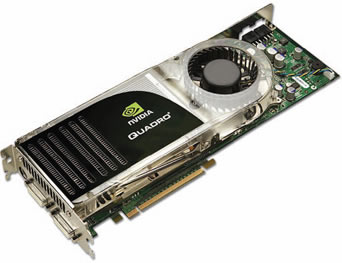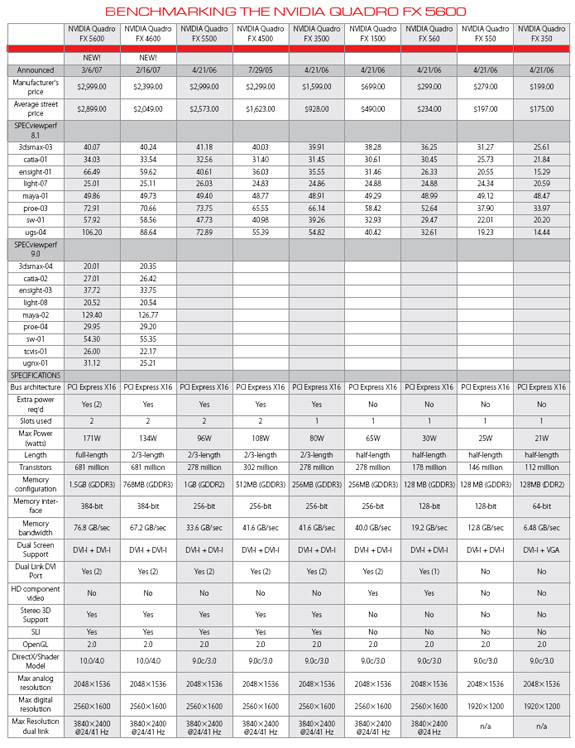Even More Graphics Power
NVIDIA sends us its most powerful graphics board ever.
Latest News
December 4, 2001
By David Cohn
 |
No sooner did we finish reviewing the Quadro FX 4600, when NVIDIA sent us its even more powerful sibling, the Quadro FX 5600. Both the 4600 and 5600 are based on NVIDIA’s new G80 GPU architecture, first introduced November 2006 in the company’s GeForce 8800 GTS and GTX cards. Like the FX 4600, the Quadro FX 5600 is targeted at high-end users that need interactive displays of large, complex models, including automotive and aerospace design, oil and gas exploration, and scientific visualization.
The NVIDIA Quadro FX 5600 is the successor to the NVIDIA Quadro FX 5500, which we reviewed last year (see June 2006 Desktop Engineering). But the FX 5600 is even more of a revolutionary step beyond its predecessor. Compared to the NVIDIA Quadro FX 4500’s OpenGL speed, the FX 4600 delivers 1.6X the performance. The new FX 5600 offers up to 2X the performance of the FX 5500 while providing 50% more framebuffer memory than the 5500.
Where the Quadro FX 5500 was a 2/3-length board measuring 4.38 in. 3 9.0 in., the Quadro FX 5600 is a full-length board that’s 13.25 in. long. The board plugs into a PCI Express X16 slot, but it’s maximum power consumption of 171 watts necessitates the use of not one, but two auxiliary connections to the system power supply. Like most other ultra high-end graphics boards, the FX 5600’s 1.5 in. depth also means that it consumes as much space as two expansion cards, making it impossible to use the adjacent expansion slot.
Like the Quadro FX 4600, the FX 5600 provides two DVI-I display connectors, both with dual link capabilities, enabling the board to power two monitors. Analog resolution tops out at 2048 3 1536, while the board can power ultra high-resolution digital displays at up to 2560 3 1600, or as high as 3840 3 2400 at 24/41Hz refresh rates. There’s also a VESA stereo connector and the board supports NVIDIA’s Quadro G-Sync and SDI option cards, providing frame lock and broadcast-quality video capabilities, respectively. Both the Quadro FX 4600 and 5600 are also the first professional graphics cards to offer support for HCP, which allows protected commercial HD DVD and Blu-Ray movies to be played back on a PC.
The FX 5600 supports SLI, which lets users combine the power of two NVIDIA Quadro FX PCI Express graphics boards to improve the performance of a single application on a single display, run two applications simultaneously on two displays with each application having its own GPU, or drive four displays from one workstation.
Like the FX 4600, the Quadro FX 5600 has a 384-bit memory width, compared to 256-bit in the older FX 5500. The new FX 5600 has 681 million transistors (compared to 278 million in the FX 5500) and comes with 1.5GB of onboard GDDR3 memory, the most of any currently available graphics accelerator. This yields a memory bandwidth of 76.8GBps. According to NVIDIA, the Quadro FX 5600 delivers 300 million triangles per second and 19.2 billion texels per second. Like other high-end boards from NVIDIA, the FX 5600 also features a 128-bit memory interface to maintain high accuracy and 12-bit sub-pixel precision.
Like the FX 4600, the new Quadro FX 5600 supports both OpenGL 2.1 and DirectX 10 with its new Shader Model 4.0, enabling complete hardware acceleration of even the very latest professional 3D graphics software, including those running on Microsoft Vista.
 |
Where previous generations of graphics cards had multiple pipelines — separate banks of vertex and pixel shaders that could only be used for accelerating vertex calculations and texturing, respectively — NVIDIA’s new G80 architecture uses a unified architecture that dynamically allocates the GPU’s power between vertex and pixel shading.
The core of the NVIDIA Quadro FX 5600 GPU is an array of 128 parallel 1.35GHz processor cores that harness massive floating point computing power, allowing maximum application performance. The new architecture is also a key part of NVIDIA’s new CUDA computing technology, which provides a standard C language interface so programmers can synchronize hybrid programs running on both CPUs and GPUs.
To quantify the performance possible with such a powerful graphics system, we performed our standard benchmark tests on the Quadro FX 5600. We installed the board in the same HP xw4200 workstation we’ve used to test every previous PCI Express workstation-class graphics accelerator.
While this computer is several generations old (and the results therefore appear slower than those published on the NVIDIA website), using the same platform for all of our reviews enables readers to make a direct comparison of all of our previously published benchmark results. Beginning with the Quadro FX 4600, we have also started testing using both SPEC viewperf 8.1 and the newer viewperf 9.0. Both sets of results are provided in the accompanying table.
The new NVIDIA Quadro FX 5600 outperformed its predecessor and matched or outpaced the FX 4600 on almost every dataset. Since none of the viewperf datasets really tax this board, we’d expect to see even more significant performance improvement in real-world applications dealing with very large models.
As is true for all of the other workstation-class graphics accelerators from NVIDIA, the Quadro FX 5600 is fully certified with most CAD and DCC applications and uses NVIDIA’s unified driver architecture (UDA). Drivers are available for Windows Vista and Window XP (both 32- and 64-bit), Windows 2000 (32-bit only), Linux 32 and 64, and Solaris. The FX 5600 can be purchased as part of a new PC or separately through selected resellers and VARs, such as PNY. The NVIDIA Quadro FX 5600 has a suggested retail price of $2,999.
NVIDIA Corporation
Santa Clara, CA
nvidia.com
> Requirements: PCI Express-based workstation with available x16 lane graphics slot; Microsoft Windows Vista (64-bit or 32-bit), Microsoft Windows XP (64-bit or 32-bit), Windows 2000 (32-bit), Linux (64-bit or 32-bit), or Solaris.
David Cohn is a computer consultant and technical writer based in Bellingham, WA, and has been benchmarking PCs since 1984. He’s a contributing editor to DE, an applications engineer with The PPI Group, and the author of more than a dozen books. Please send comments about this article to DE-Editorsmailto:[email protected]. You can also contact David at [email protected] or at dscohn.com.
Subscribe to our FREE magazine, FREE email newsletters or both!
Latest News
About the Author
David Cohn is a consultant and technical writer based in Bellingham, WA, and has been benchmarking PCs since 1984. He is a Contributing Editor to Digital Engineering, the former senior content manager at 4D Technologies, and the author of more than a dozen books. Email at [email protected] or visit his website at www.dscohn.com.
Follow DE





